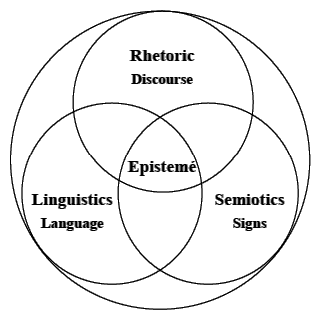
 As the Hermeneutics of Narrative diagram illustrates, the two bottom circles—labeled Semiotics and Linguistics—exemplify the relationship between these fields and Rhetoric. That is, these two fields of research serve as the hermeneutic basis, as it were, for Rhetoric. Semiotics, the general study of the meaning of signs, prepares the reader for the more specific task of understanding the various signs—words, gestures, and tones—employed in the language of narrative. And Linguistics itself supplements the field of Semiotics as one of the specific applications of the more generalized semiotic theory. As with the semiotic study of film or of the communication involved in DNA replication, Linguistics contributes real-time data to research in the more theoretical field of Semiotics. As the Hermeneutics of Narrative diagram illustrates, the two bottom circles—labeled Semiotics and Linguistics—exemplify the relationship between these fields and Rhetoric. That is, these two fields of research serve as the hermeneutic basis, as it were, for Rhetoric. Semiotics, the general study of the meaning of signs, prepares the reader for the more specific task of understanding the various signs—words, gestures, and tones—employed in the language of narrative. And Linguistics itself supplements the field of Semiotics as one of the specific applications of the more generalized semiotic theory. As with the semiotic study of film or of the communication involved in DNA replication, Linguistics contributes real-time data to research in the more theoretical field of Semiotics.
 Semiotics and Linguistics, taken together, serve as the backdrop and basis—the context, as it were—for the field of Rhetoric. This third field, in turn, provides the fuller, more culturally oriented and critically aware attitudes and techniques of higher literary criticism that function in the process of narrative hermeneusis. Not unlike the Poetics of traditional critical theory (as we have this from Aristotle), Rhetoric here serves to develop the standards of measurement and the axes of orientation, metaphorically speaking, for an approach to the understanding and interpretation of narrative. The traditional ideas of Rhetoric—in particular Aristotle's three forms of rhetorical Appeal (which are based upon the physical structure of the act of communication) but also the all important concept of the rhetorical context—are transformed in this "New Rhetoric" into more universal tools for the understanding and interpretation of discourse. And of course, Rhetoric itself will feed practical and theoretical information back to its basis—Semiotics and Linguistics—the other two component fields, as will these latter two into Rhetoric, thereby providing us with a comprehensive hermeneutic methodology. Semiotics and Linguistics, taken together, serve as the backdrop and basis—the context, as it were—for the field of Rhetoric. This third field, in turn, provides the fuller, more culturally oriented and critically aware attitudes and techniques of higher literary criticism that function in the process of narrative hermeneusis. Not unlike the Poetics of traditional critical theory (as we have this from Aristotle), Rhetoric here serves to develop the standards of measurement and the axes of orientation, metaphorically speaking, for an approach to the understanding and interpretation of narrative. The traditional ideas of Rhetoric—in particular Aristotle's three forms of rhetorical Appeal (which are based upon the physical structure of the act of communication) but also the all important concept of the rhetorical context—are transformed in this "New Rhetoric" into more universal tools for the understanding and interpretation of discourse. And of course, Rhetoric itself will feed practical and theoretical information back to its basis—Semiotics and Linguistics—the other two component fields, as will these latter two into Rhetoric, thereby providing us with a comprehensive hermeneutic methodology.
|

